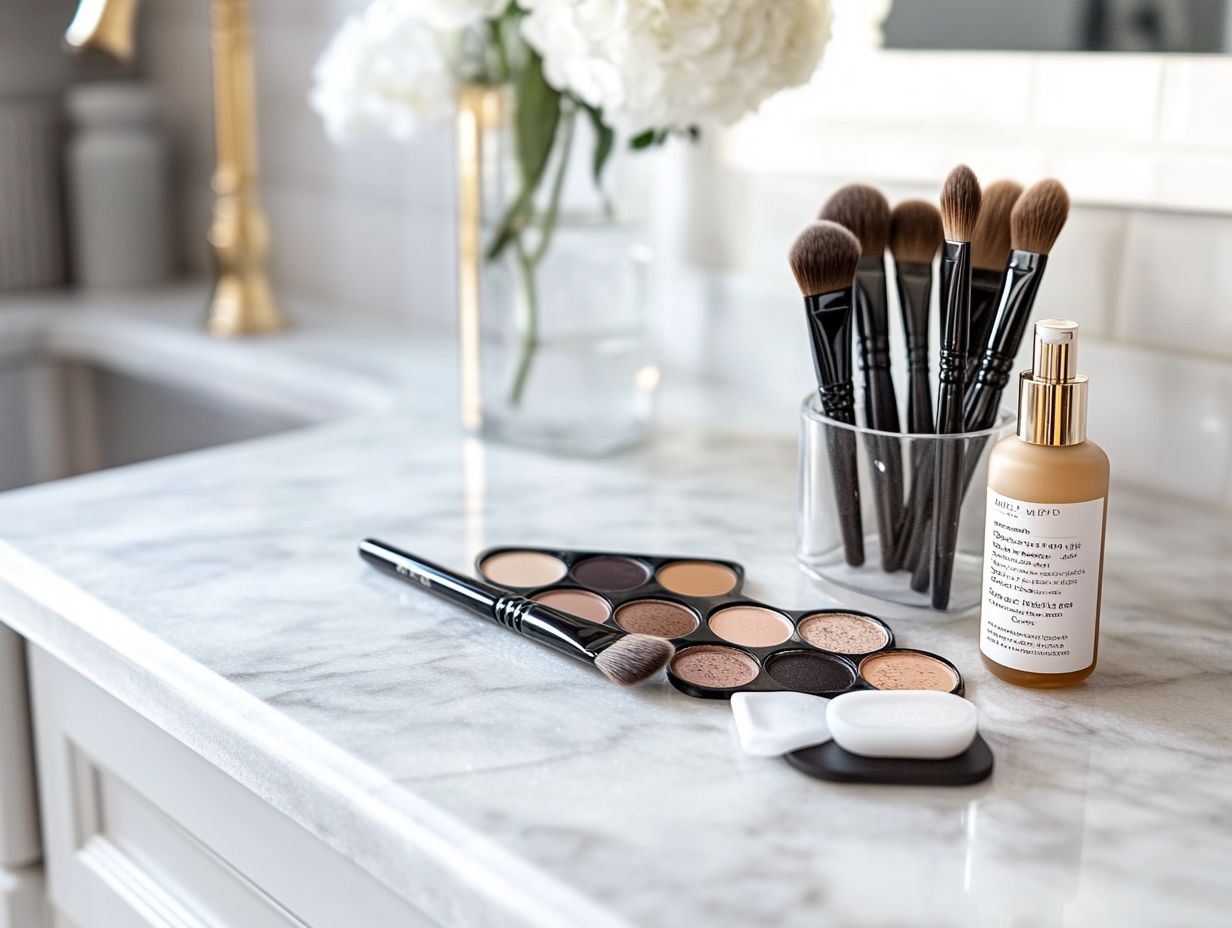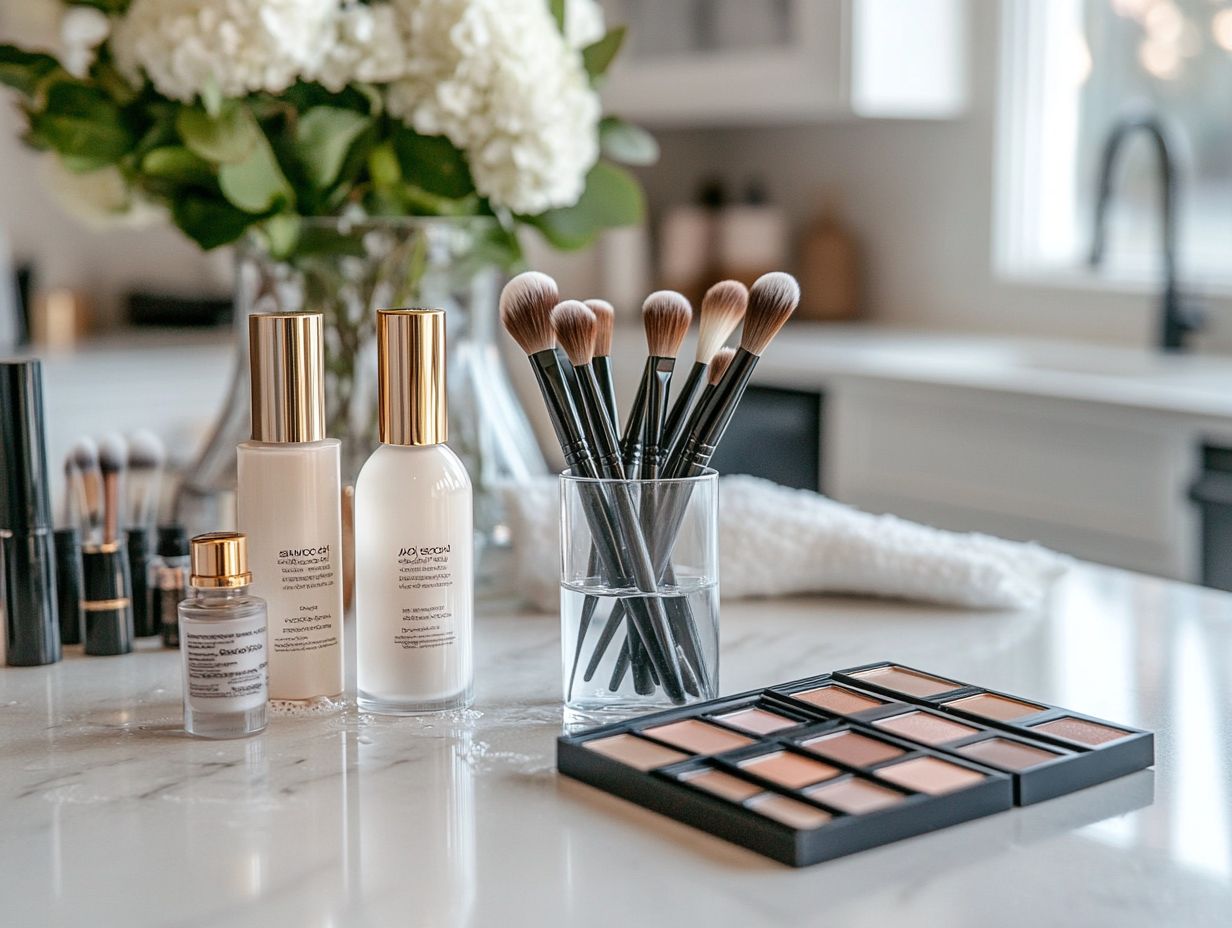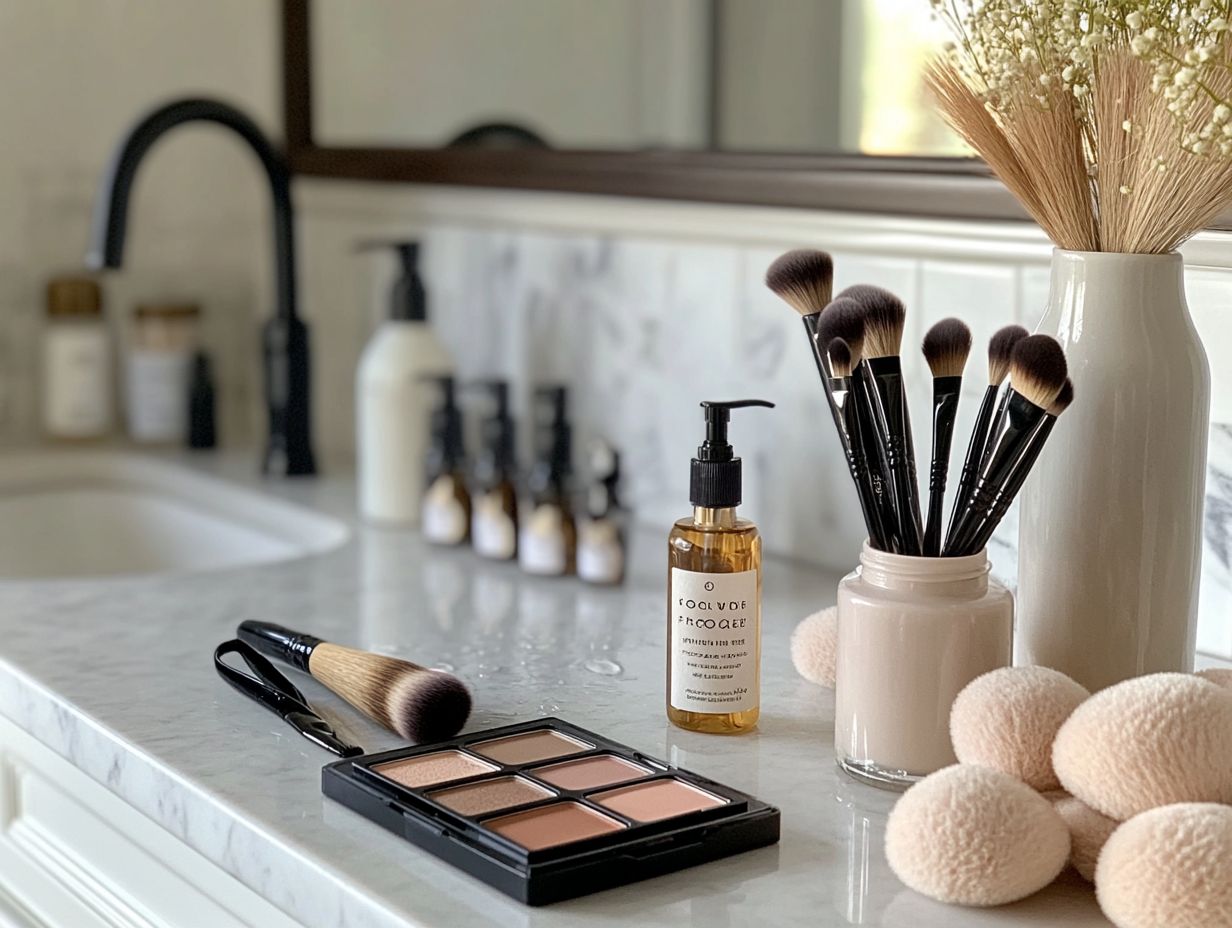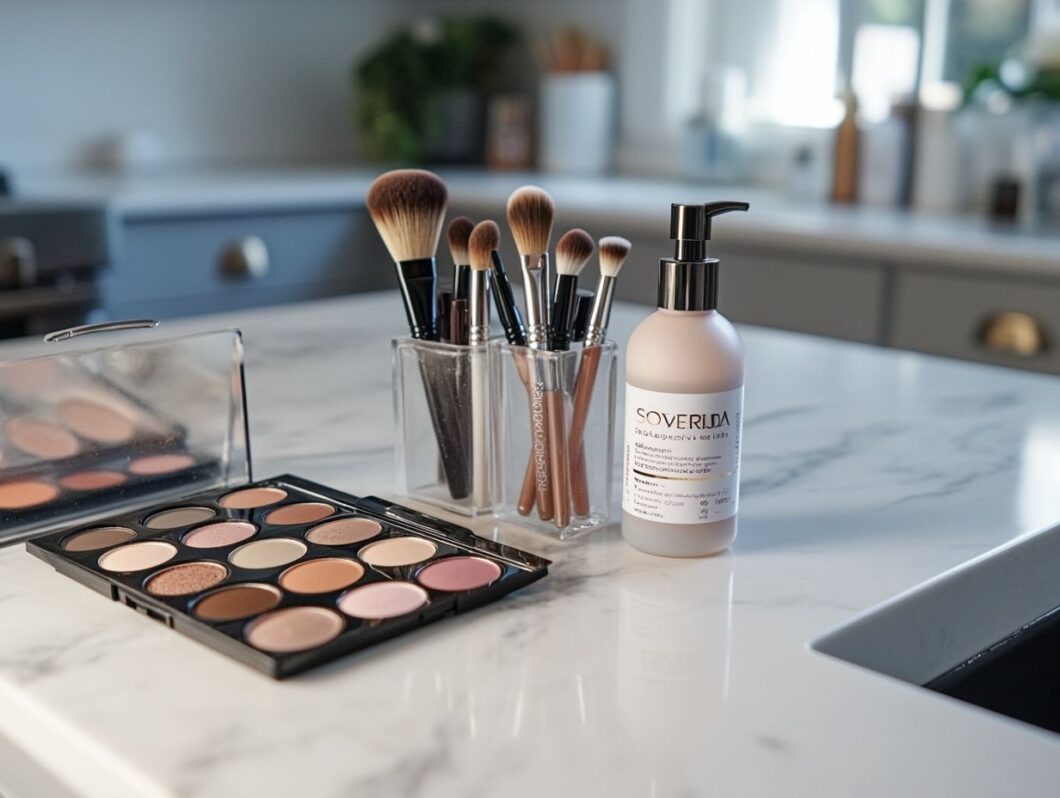Maintaining clean makeup tools, including makeup brushes, is essential for both my health and beauty routine. I understand that dirty brushes and sponges can harbor bacteria, which may lead to skin irritations and breakouts. Additionally, unclean tools can negatively impact the application and longevity of my makeup. In this article, I will explore the potential health risks associated with unclean tools, discuss the right products and techniques for effective sanitization, including the use of cleaning agents, and share valuable tips for keeping my makeup arsenal in pristine condition. I will also outline how often I should sanitize my tools and provide helpful preventive measures to ensure that my beauty tools, including makeup brushes, remain safe and effective.
Key Takeaways:
Why Sanitizing Your Makeup Tools is Important

Sanitizing my makeup tools is crucial for maintaining skin health and preventing various bacterial infections, including those caused by E. coli and Staphylococcus aureus. I understand that regularly cleaning my makeup brushes and tools can significantly reduce the risk of acne breakouts and skin infections caused by harmful bacteria such as E. coli and Staphylococcus aureus.
Dermatologists, including Jeanine B. Downie, emphasize that dirty makeup tools can harbor dirt, oil, and bacteria, potentially leading to serious consequences for my skin. Therefore, by ensuring that my brushes and other makeup tools are properly sanitized, I not only maintain their quality and effectiveness but also contribute positively to my overall skincare routine. Recent analysis from Forbes suggests that dangerous microbes can indeed hide in makeup products, further underscoring the importance of proper hygiene practices.
Potential Health Risks
Using unclean makeup brushes can present significant health risks, including potential skin infections and acne breakouts due to the bacteria that accumulate on these tools. When I neglect to sanitize my makeup brushes, I inadvertently create a breeding ground for harmful microorganisms, such as bacteria and fungi.
These pathogens can thrive in the bristles of unwashed brushes, resulting in skin irritation, rashes, and even more severe conditions like folliculitis, which is the inflammation of hair follicles. If this buildup remains unchecked, it can escalate into serious infections, such as fungal infection, that may require medical intervention.
By regularly cleaning my brushes with antibacterial soap, I not only eliminate these harmful organisms but also promote healthier skin and enhance the effectiveness of my makeup application. Neglecting this simple yet essential step can lead to adverse skin reactions that detract from my overall beauty routine. For context, The Conversation reports that 90% of makeup bags contain deadly bugs, highlighting the widespread risk of bacterial contamination.
Effects on Makeup Application
The condition of my makeup brushes significantly affects the effectiveness of my makeup application. Using dirty brushes can result in uneven application and diminish the longevity of my makeup.
When I choose liquid and cream products, the distinction between high-quality professional brushes and disposable alternatives becomes even clearer. Professional brushes, often made from premium materials, not only enhance my application but also ensure that each stroke blends products seamlessly into the skin.
Conversely, using dirty or substandard brushes can introduce bacteria and dead skin cells, compromising the overall finish and potentially leading to skin irritations. For any makeup artist striving for flawless results, maintaining a clean makeup kit-especially by regularly washing brushes-is essential.
A proper cleanse allows the vibrant tones of foundations or concealers to truly shine, while dirty tools can dull even the most exquisite formulations.
Tools and Products You Need for Sanitizing

To effectively sanitize my makeup tools, I ensure that I have the appropriate tools and products available, including specialized cleaning solutions and disinfecting brushes designed for makeup hygiene.
I find that high-quality cleaning agents, such as 70% isopropyl alcohol, serve as an effective disinfectant for brushes, effectively eliminating bacteria.
Additionally, utilizing a reliable spray bottle facilitates easy application of these solutions.
A casual reference from the Environmental Protection Agency highlights six steps for safe and effective disinfectant use, emphasizing the importance of using the right products wisely. By investing in the right cleaning brushes, I can extend the lifespan of my high-quality makeup tools while maintaining a clean and hygienic environment for my makeup application.
Essential Cleaning Products
Essential cleaning products for sanitizing my makeup tools include specialized cleaning solutions, brush disinfectants, and antibacterial soaps specifically designed for makeup hygiene.
As a makeup enthusiast, I often rely on reputable brands such as MAC cleaner, Nyx, and Real Techniques to keep my brushes in pristine condition. These products not only promise an effective clean but also emphasize the longevity of my tools by preventing bristle damage, which can occur from using harsh or incorrect detergents.
Utilizing the right cleaning solution is crucial for me, as it helps remove makeup residue, oils, and bacteria that could lead to skin irritations or breakouts. Regular maintenance with trusted cleaning agents not only promotes optimal performance during makeup application but also protects the integrity of my skin, making it an essential step in my beauty regimen.
Recommended Tools
I recommend using a variety of tools to maintain the cleanliness of my makeup brushes, including a brush cleaning container, specialized cleaning tools, and innovative UV-C LED sanitizers that effectively eliminate harmful bacteria.
These essential items enable me to achieve thorough cleansing and rejuvenate my brushes for a flawless application. Brush cleaning containers often feature compartmentalized sections, which allow for effective soaking and separate rinsing of brushes, thereby preventing cross-contamination of products.
I also find that specific cleaning tools, such as silicone brush cleaning mats or glove sets, provide textured surfaces that gently yet effectively dislodge product buildup.
For those of us who prioritize hygiene, UV-C LED technology offers a powerful solution; its ability to eliminate 99.9% of germs fosters a healthier makeup routine, which is especially valued by professional makeup artists.
As a professional, I consistently choose advanced cleaning methods to uphold optimal hygiene standards, ensuring that my tools remain in the best condition for client use.
Step-by-Step Guide to Sanitizing Your Makeup Tools

I find that having a step-by-step guide for sanitizing my makeup tools is essential for keeping my brushes in optimal condition and free from harmful bacteria.
By following a structured routine that incorporates a reliable cleaning solution and the appropriate cleaning brushes, I can enhance the effectiveness of my makeup application while maintaining my skin’s health.
Whether I’m working as a makeup artist or simply applying makeup for personal use, implementing these brush cleaning tips significantly reduces the risk of skin infections and promotes overall hygiene.
Cleaning and Disinfecting Techniques
Effective cleaning and disinfecting techniques for my makeup brushes involve utilizing both a suitable cleaning solution and an appropriate brush cleaning container to ensure my tools are thoroughly cleansed.
Selecting the right cleaning solution is crucial; I often opt for 70% isopropyl alcohol, which is widely recognized for its effectiveness in eliminating germs and bacteria. To maximize the benefits of this disinfectant, I dip the bristles of each brush into the alcohol and gently swirl them until the makeup residues disperse.
A dedicated brush cleaning container enhances this process, often featuring textured surfaces designed to lift dirt away more efficiently.
Regular maintenance is essential; I establish a cleaning schedule every one to two weeks to prevent product buildup and prolong the lifespan of my brushes. Prioritizing this practice not only guarantees a flawless application but also promotes skin health, significantly reducing the risk of breakouts or irritation.
Incorporating cleaning into my beauty routine is a fundamental aspect for any serious makeup enthusiast.
How Often Should You Sanitize Your Makeup Tools?
Determining the frequency of sanitizing my makeup tools is crucial for maintaining proper personal hygiene and preventing potential skin infections that may result from using dirty brushes.
Recommended Frequency

I recommend cleaning makeup brushes at least once a week, although some professional makeup artists suggest daily cleaning for brushes used on multiple clients. This practice effectively removes any residual makeup products, oils, and bacteria, which ultimately promotes better skin health and allows for a more seamless application.
For personal-use brushes, a weekly cleaning is usually adequate since they are typically used by one individual, minimizing the risk of cross-contamination. However, if I frequently use creams or foundations, a more frequent cleaning schedule can benefit both the brushes and my skin.
To maintain proper brush hygiene, I utilize gentle soaps or specialized brush cleansers designed to eliminate grime without harming the bristles. It’s essential to allow brushes to dry naturally and avoid storing them while damp, as this can lead to mold growth.
By implementing these insights from professional makeup artists, I can prolong the life of my brushes and enhance the overall quality of my makeup application.
Tips for Maintaining Clean Makeup Tools
Maintaining clean makeup tools requires more than just regular sanitization; it necessitates the implementation of preventive measures, endorsed by dermatologists and estheticians, and the use of effective cleaning agents and tools to extend the lifespan of my makeup kit.
Preventive Measures
Implementing preventive measures is essential for maintaining the cleanliness of my makeup brushes and preventing the buildup of dirt, oil, and bacteria.
To achieve this, I ensure that I store these tools in a clean, dust-free environment, preferably in a case or holder that minimizes exposure to harmful elements. Regularly cleaning my brushes with antibacterial products, such as a high quality MAC cleaner, not only removes makeup residue but also helps prevent skin irritations and breakouts, seamlessly aligning with my comprehensive skincare routine endorsed by dermatologist Jeanine B. Downie.
This practice, utilizing UV-C LED technology, not only extends the life of my tools but also enhances the overall effectiveness of my makeup application. By incorporating these straightforward yet effective measures into my daily habits, I can foster healthier skin while enjoying a flawless makeup experience with one-time-use brushes, ultimately achieving a harmonious balance between beauty and skincare, as highlighted in recent makeup trends.


